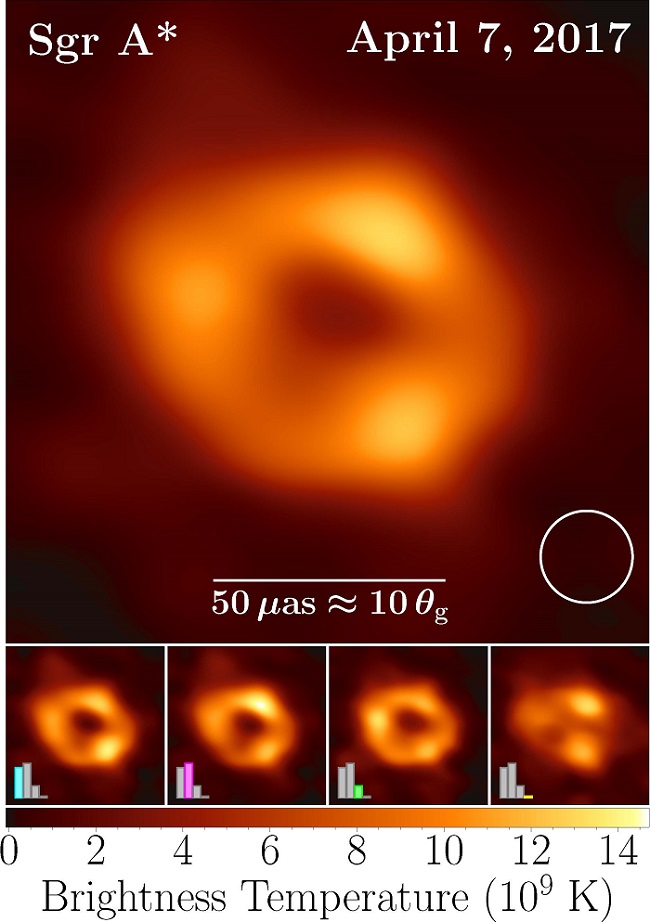
Scientists from the Event Horizon Telescope (EHT) collaboration have revealed the first image of the supermassive black hole at the centre of our galaxy, the Milky Way. The results obtained by an international team – which involved Italian scientists from National Institute for Astrophysics (INAF), National Institute for Nuclear Physics (INFN), University of Naples Federico II and University of Cagliari – are described in several articles published in a special issue of The Astrophysical Journal Letters.
Scientists had previously discovered a star orbiting around an invisible and very massive object which they assumed was a black hole. The extraordinary image obtained by the EHT researchers now provides the first visual evidence that Sagittarius A* (Sgr A*) – this is the name of the object – is actually a black hole, offering researchers valuable clues about the behaviour of such bodies, which are believed to reside at the centre of most galaxies.
The image released is an average of images extracted by the research team and captured by the Event Horizon Telescope, a powerful instrument that links together eight radio observatories around the world to form a single Earth-sized virtual telescope. The name of the project refers to the event horizon, the threshold of a black hole beyond which nothing can escape.
In the “photograph” taken by the researchers, we cannot see the black hole itself, which cannot emit light, but the glowing gas around it, characterized by a dark central region called the “shadow” of the black hole, surrounded by a bright ring-like structure. The image captures the light bent by the powerful gravity of the black hole, which is four million times the mass of our Sun.
“This is an extraordinary achievement, the importance of which we will only realize over time,” said University and Research Minister Maria Cristina Messa. “Congratulations to the large and global team that made it possible to achieve it, and, within it, to the Italian scientists. This discovery shows how fundamental international research networks are for the progress of all, how important it is for Italy to be part of them and invest, in a continuous and stable way over the years, in large research and data infrastructures, to strengthen and implement them more and more, and how an effort must be made to preserve these networks even in times of crisis. This result also reminds us that we do not always have to be in a hurry to achieve a certain result in a short time. Research takes time and we must be patient and wait, knowing that it will always be worth it.”
The image of Sgr A* looks very similar to that of the black hole at the centre of the galaxy M87: the first image of a black hole obtained by the Event Horizon Telescope and released in 2019. Even though the two “photographs” look very similar, the black hole at the centre of our galaxy is more than a thousand times smaller and less massive than M87. “We have two completely different types of galaxies and two very different black hole masses, but close to the edge of these black holes they look amazingly similar,” explained Sera Markoff, Professor of Theoretical Astrophysics at the University of Amsterdam, The Netherlands, and Co-Chair of the EHT Science Council. “This tells us that General Relativity governs these objects up close, and any differences we see further away must be due to differences in the material that surrounds the black holes.”
Sagittarius A* is much closer to us than the black hole M87 but it is much smaller, and therefore it was more difficult to capture an image. The research team had to develop sophisticated new data analysis tools that accounted for the gas movement around Sgr A*. This gas takes just minutes to complete an orbit around it, whereas it takes days to weeks to orbit the much larger M87. “Variability is one of the critical aspects of Sgr A*: while it represents a major challenge for imaging the galactic centre, it also provides us with a fundamental tool for investigating the physical processes that take place there,” commented Nicola Marchili, INAF researcher, who worked on the analysis of data on the temporal variability of the black hole.
“In addition to developing new tools to image Sgr A*, the team produced millions of images with different combinations of parameters for the various imaging algorithms, using large computational infrastructures,” added Rocco Lico, INAF associate, co-leader of one of the data analysis groups in the Imaging working group and Information-technology officer of the EHT collaboration. “During this process, the team compiled an unprecedented library of simulated black holes to compare with the observations.”
The work of the Event Horizon Telescope collaboration, however, continues. “The EHT network is expanding and undergoing significant technological upgrades: we will be able to obtain even more impressive images and even the first movies of black holes in the near future,” said Ciriaco Goddi, Professor at the University of Cagliari, INAF and INFN associate, who has been part of this effort since 2014 as coordinator of the European group of BlackHoleCam, one of the projects the EHT Collaboration originated from. Another observation campaign, which included three new radio telescopes, was carried out in March 2022.

